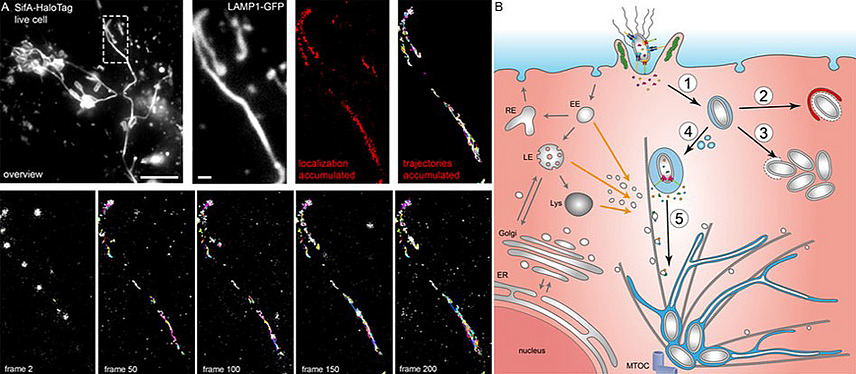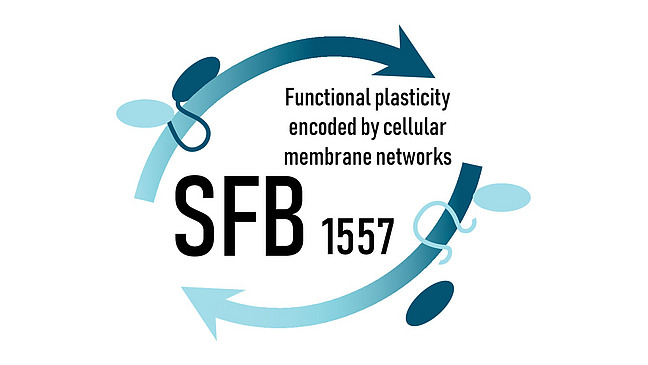Project P8 | Michael Hensel
Dynamic manipulation of functional plasticity of the host cell endosomal system by an intracellular pathogen
We explore how Salmonella infection and secretion of its effectors reprograms the mammalian endosomal membrane system to promote replication in its intracellular niche.

Project Summary
Salmonella enterica is a clinically important invasive and facultative intracellular bacterial pathogen. Intracellular S. enterica serovar Typhimurium (STM) manipulate their mammalian host cells in a unique manner, resulting in the formation of the Salmonella-containing vacuole (SCV).
A key virulence factors for the intracellular lifestyle of STM is the type III secretion system (T3SS) encoded by genes located on Salmonella pathogenicity island 2 (SPI2), and a set of effector proteins translocated by the SPI2-T3SS. The SCV has several properties of late endosomal/lysosomal endosomes, but is permissive for STM survival and replication.
Intracellular STM induce, by means of SPI2-T3SS effector proteins, massive remodeling of the host cell endosomal system. Continuous recruitment of endosomal membranes to the SCV is crucial to safeguard the integrity of this membrane compartment, to prevent pathogen release into the host cell cytosol, and for nutritional supply.
The resulting network of Salmonella-induced filaments (SIF) is connected to the SCV. SIF have a complex architecture of double membrane tubular compartments that entrap host cell cytosol. SIF formation depends on function of a subset of SPI2-T3SS effector proteins that are also associated with, or integrated in membranes of SIF and SCV. The mechanisms how the effector proteins are targeted to endosomal membranes and manipulate the functional plasticity of the mammalian endosomal system will be investigated in this project.
-
Reuter, T., Scharte, F., Franzkoch, R., Liss, V., Hensel, M. (2021). Single cell analyses reveal distinct adaptation of typhoidal and non-typhoidal Salmonella enterica serovars to intracellular lifestyle. PLoS Pathog. 17, e1009319. 10.1371/journal.ppat.1009319.
-
Reuter, T., Vorwerk, S., Liss, V., Chao, T.C., Hensel, M., Hansmeier, N. (2020). Proteomic analysis of Salmonella-modified membranes reveals adaptations to macrophage hosts. Mol. Cell. Proteom. 19, 900-912.
-
Röder, J., Felgner, P., Hensel, M. (2021). Comprehensive single-cell analyses of the nutritional environment of intracellular Salmonella enterica. Front. Cell. Infect. Microbiol. 11, 624650. 10.3389/fcimb.2021.624650.
-
Kehl, A., Göser, V., Reuter, T., Liss, V., Franke, M., John, C., Richter, C.P., Deiwick, J., Hensel, M. (2020). A trafficome-wide RNAi screen reveals deployment of early and late secretory host proteins and the entire late endo-/lysosomal vesicle fusion machinery by intracellular Salmonella. PLoS Pathog. 16, e1008220.
-
Göser, V., Kommnick, C., Liss, V., Hensel, M. (2019). Self-labeling enzyme tags for analyses of translocation of type III secretion system effector proteins. mBio. 10. 10.1128/mBio.00769-19.
-
Liss, V., Swart, A.L., Kehl, A., Hermanns, N., Zhang, Y., Chikkaballi, D., Böhles, N., Deiwick, J., Hensel, M. (2017). Salmonella enterica remodels the host cell endosomal system for efficient intravacuolar nutrition. Cell Host Microbe 21, 390-402.
-
Liss, V., Hensel, M. (2015). Take the tube: remodelling of the endosomal system by intracellular Salmonella enterica. Cell. Microbiol. 17, 639-647. (Review)
-
Vorwerk, S., Krieger, V., Deiwick, J., Hensel, M., Hansmeier, N. (2015). Proteomes of host cell membranes modified by intracellular activities of Salmonella enterica. Mol. Cell. Proteom. 14, 81-92.
-
Krieger, V., Liebl, D., Zhang, Y., Rajashekar, R., Chlanda, P., Giesker, K., Chikkaballi, D., Hensel, M. (2014). Reorganization of the endosomal system in Salmonella-infected cells: the ultrastructure of Salmonella-induced tubular compartments. PLoS Pathog. 10, e1004374.

